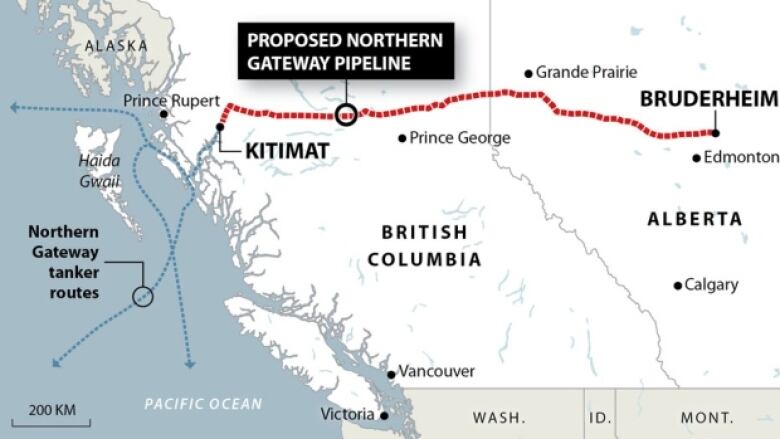Northern Gateway pipeline's doubled-up challenge
Enbridge pipeline project has 2 pipes, one flowing east, one west, carrying 2 different products
The Northern Gateway pipeline has the thumbs-up from the National Energy Board and the federal cabinet. Now all Enbridge has to do is meet all 209 of those conditions attached to the decision.
That could take a while. Once Enbridge does that, though, and assuming it makes it through any other roadblocks that stand in the way, the company can get down to building theproject.
- Northern Gateway pipeline approved with 209 conditions
- Northern Gateway not alone: 5 other pipelines to watch
- Map: Canada's main pipeline network
But how familiar is the Canadian public with the full scope of the project?
A lot of attention has been focused on the pipe that wouldcarry diluted bitumenfrom Alberta to the B.C. coast. But doyou know that Northern Gateway is a two-pipe project?
Green Party Leader Elizabeth May does. And this is what she said in the foyer of the House of Commons on Tuesday.

2-way flow
That fact surprises a lot of people. A second pipewouldflow east and carry 193,000 barrels of diluent (also known as condensate) a day.
So what is this diluent?It is a "pentane," according to Greg Stringham, a chemical engineer and a vice-president with the Canadian Association of Petroleum Producers.
"It is a light hydrocarbon. So it is kind of like gasoline," he explained.
Most of it is a byproduct of natural gas production,thoughsome also comes from the oil refining process.
When natural gas comes up out of the ground, some of the heavier parts turn into a liquid. They call that condensate, and that is what they mix with bitumen to make it flow through a pipeline.
Mostdiluent comes from the United States and Canada, though May said somecomes from the Middle East.
Why do they have to mix it in with bitumen? Here is the Green Party leaderagain. Picture May holding a wide-mouthed glass jar with some black stuff in it. The black stuff isn't moving even though she's got the jar upside down. (Or just click on the video at the top of the story.)
"Here's raw bitumen [pause for effect]. Note: it does not flow easily. It's a solid."
The heavier end of normal oil
Stringham prefers calling it the heavier end of normal oil.

Nowadays, that stuff gets scooped out and hauled off to a facility where it essentially gets a warm bath, is shaken in the water and left to stand for a while.
"It's kind of like Italian salad dressing," said Stringham.
"The sand will go to the bottom. The water goes to the middle. And the oil floats on the top."
They scrape the heavy oiloff the top, mix in some diluent and voila diluted bitumen, ordilbit, which according toStringhamis not two separate substances but one whole new liquid.
"The analogy I kind of like using is it's almost like cream in coffee or Kool-Aid in water. When you mix it together it becomes a new substance," saidStringham.
So your hydrocarbon-flavoured Kool-Aid is ready to ship back to the coast in your 525,000-barrels-a-day pipe.
What does May have to say about that?
"It is a twinned pipeline over a thousand kilometres, over some of the most rugged wilderness."

"It involves going through fragile areas. It involves engineering challenges," she added.
'Acceptable risk'
Of course, engineers love challenges, and they willtell you there isn't any challenge that can't be overcome,provided you have enough money or a high enough risk tolerance.
"Sometimes people ask: can you build something across any place? Of course you can. But then you have to think about acceptable risk," said Dharma Wijewickreme, a geotechnical engineer who has worked in the Canadian pipeline industry for the last 24 years and teaches at the University of British Columbia.
"The lower the risk mark you want to have, the higher the cost of any one project will be," he added.
So what level of risk is May willing to tolerate?
"Next step is encouraging all British Columbians to use all democratic and peaceful and legal means to stop this pipeline."
Enbridge is probably happier to opt for the 209 conditions over the Green Party leader's price.













_(720p).jpg)


 OFFICIAL HD MUSIC VIDEO.jpg)
.jpg)



























































































